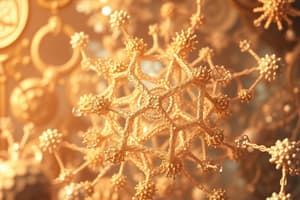Podcast
Questions and Answers
What is the approximate distance for atomic structure?
What is the approximate distance for atomic structure?
- 10^-10 m (correct)
- 1 cm
- 1 m
- 100 nm
What determines the nature of atomic bonding in materials?
What determines the nature of atomic bonding in materials?
The structure of the atom
The mass of each electron is greater than the mass of each proton.
The mass of each electron is greater than the mass of each proton.
False (B)
What is the atomic number of an element equal to?
What is the atomic number of an element equal to?
The unit of atomic mass is ______.
The unit of atomic mass is ______.
Calculate the number of atoms in 100 g of silver (Ag). What is the atomic mass of silver?
Calculate the number of atoms in 100 g of silver (Ag). What is the atomic mass of silver?
Which of the following is true about the spin quantum number?
Which of the following is true about the spin quantum number?
The atomic mass of iron is ______ g/mol.
The atomic mass of iron is ______ g/mol.
How many protons, electrons, and neutrons are found in a Cl- ion formed from Cl-35?
How many protons, electrons, and neutrons are found in a Cl- ion formed from Cl-35?
What are the four quantum numbers that define the energy level of each electron?
What are the four quantum numbers that define the energy level of each electron?
Study Notes
Levels of Structure of Materials
-
The structure of materials is analyzed at different levels, each influencing properties and behavior.
-
Atomic Structure:
- Scales to around 1 Angstrom (10^-10 meters).
- This level involves understanding the individual atoms and their components: protons, neutrons, and electrons.
-
Short-range and Long-range Atomic Arrangement:
- How atoms are organized, considering their immediate neighbors (short-range) and larger-scale structures (long-range).
-
Nanostructure:
- Scale from 1 to 100 nanometers.
- This involves features and properties arising from these very small structures.
-
Microstructure:
- Scale from 100 to 100,000 nanometers to 100 micrometers.
- Microstructures include features like grains and phase boundaries.
-
Macrostructure:
- Scale greater than 100 micrometers.
- This level includes the overall shape and form of materials.
Why Atomic Structure is Important in Engineering Materials
-
Understanding atomic structure is crucial for predicting the properties of materials.
-
The type of atomic bonding dictates:
- Melting point
- Elasticity
- Thermal expansion
-
By tailoring bonding mechanisms, specific performance requirements can be met.
Structure of an Atom
-
The atom consists of a nucleus surrounded by electrons.
-
The nucleus contains protons (positively charged) and neutrons (no charge).
-
Electrons (negatively charged) are attracted to the nucleus by electrostatic forces.
-
Each proton and electron carries a charge of 1.60 x 10^-19 Coulombs.
-
The atomic number of an element is equal to the number of protons in its atom.
-
For a neutral atom, the number of protons equals the number of electrons.
Mass of an Atom
-
Protons and neutrons have a mass of approximately 1.67 x 10^-24 grams.
-
Electrons are much lighter, weighing around 9.11 x 10^-28 grams.
-
Atomic Mass (M): Represents the average mass of an atom, considering the combination of protons and neutrons, expressed in atomic mass units (amu).
-
Avogadro's Constant (NA): 6.022 x 10^23 atoms or molecules/mole.
-
Atomic mass is also the mass of Avogadro's number of atoms in grams.
Electronic Structure of an Atom
-
Electrons occupy specific energy levels within the atom.
-
No more than two electrons can occupy the same energy level.
-
Each element has a distinct energy level configuration.
-
Four quantum numbers describe electron properties:
- Principal Quantum Number (n): Defines the energy levels or quantum shells.
- Azimuthal Quantum Number (l): Describes the energy levels within each shell, also known as sublevels or orbitals.
- Magnetic Quantum Number (ml): Specifies the orbitals associated with a particular azimuthal quantum number.
- Spin Quantum Number (ms): Represents the spin of an electron, which can have two possible values (+1/2 and -1/2).
Studying That Suits You
Use AI to generate personalized quizzes and flashcards to suit your learning preferences.
Related Documents
Description
This quiz explores the different levels of material structure from atomic to macro scales. It covers atomic structure, nanostructure, microstructure, and macrostructure, emphasizing the significance of each level in determining material properties. Test your knowledge on how these structures influence the behavior of materials.




